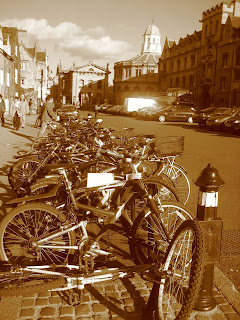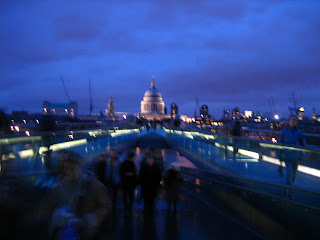

A SERIES OF EXTREMELY INSPIRING EXPERIENCES HAVE come my way in the last 24 hours. I will post about them here, seperately. I got up this morning after falling asleep, as per ususal lately, with one index finger snug in the book (which happens to be Gregory David Roberts' memoir, Shantaram right now) that i'd been reading when i drifted off, the lamp still on and everything. It's cold in London right now. Very cold. We have had several boughts of ice and snow whipped horizontally by 25 mph winds, which become wretched rain showers, and make the temperature feel as though it has dipped below freezing. So, spring lasted a week. It will be back, and the trees are still budding, though the last snows seemed to have shrivelled the daffodills for good. Anyway, I have been saving a trip to Hampstead Heath--a former village that is now part of Greater London to the north of the city center--for a long day, and a nice one. On waking this morning, though, I didn't feel like waiting anymore. I packed an orange, a couple of books, my habitual map, and both sunglasses and my umbrella (such is the weather in London), as well as a hat, gloves, and an extra sweater to layer in case the wind really whipped at the Heath.
I made my way there via a few of my favorite charity shops (or "thrift shops" in amerispeak). First, the one on Vauxhall Bridge road that is on the scenic route through my neighborhood to the closest tube stop. Then I rode the train for half a dozen stops, and got out at Nottinghill, the chic mouth of the Portobello Road Markets that come alive every saturday. It's not my favorite section of the markets; that title belongs to the Ladbroke Grove train stop at the other end, where every saturday hundreds of ad-hoc stalls are constructed from pipes and plastic, full of bins that exist just so you can plung your hand in up past the elbow and pull out a forty-year-old cotton scarf, which is back in vogue. The Portobello markets are as dizzying as any open-air market...and the wares run the gamut from trendy vintage clothes, independent designer bohemian wonders, in-house telephones shaped like an ear of corn (yes, it's real! and yes, i wanted to buy it!), the best falafel I've ever tasted, antiques, street performers, stores that combine asian and native american traditional dress (strange, no?), every type and color of hat or boot a person could want, and Myrtle Beach t-shirts from the 1960's forward (that's right, Mom. If only you had kept all the stuff from the giftshop at the amusement park...we could charge £20 (40 american dollars) for one of those hideous orange airbrushed numbers...).
So, the markets. I made two £1 purchases at a thrift store--a purple t-shirt bearing the words "pour la frime"(french for god-knows-what...but i think maybe something about for the society?...i'll update when my Parisian friend Alexia gets back to me on that...) and the most incredible pair of piano-inspired flats with a tiny kitten-heel and a cut that allows the proper amount of toe cleaveage to show. I love making an incredible find at a thrift store. It takes hours, and sometimes you completely strike out...but there in a floor-level shelf in the back corner of the dank and dusty show, under some baby bibs, were the piano shoes...in my size...for £1! I struck gold! (let me briefly put this in context for those of you who do not torture yourselves with living in the second most expensive city in the world (at least i'm not in Tokyo, I guess)...a pair of shoes at a regular chain shoe-store, the equivilent of DSW or Payless will cost you from £30 on up....that is, $60...and I am talking that much money for children's shoes...like for keds. Occasionally, Camden Market's shoestores dip down to £10 or £15...and thrift shops sell for as little as £8...but £1!! never, £1!!! )...Here are the beloved new shoes:
 I have never gushed about my role in world-capitalism before on this blog. Perhaps, dear reader(s), you think me a bit shallow now? That's alright. For me clothing is exactly what the root of the word textile implies...clothing is a text. It is a visual language spoken, rather unconsciously usually, by everyone graced with sight on this planet. What you wear is a carefully constructed message, even when it's not. So, I can't bring myself to affect the erudite distain for the body. Rather, I turn my body into a canvas, in the less permanent alternative to tattoos...which are hip now...but also reveal something deeper about the age in which we live...people's attachment to visual stimulation, their sense of personal autonomy, and construction of media...but that's another post altogether. So, clothing. If you are a regular reader of the Green Eyed Muse, you know that I make/embellish a lot of my own clothes. It's a creative outlet. The story is similar with my affinity for "thrifting." Anyone with enough money can go to a designer store and find a gorgeous piece of clothing to wear for every day of the week. This is especially true in London. In London you can drop millions of pounds on one outfit, if you so choose. I prefer to be a bottom feeder to this chain, though. Thrifting is down-and-dirty work. You can't carry a cup of coffee into a thrift store, not if you're serious about it. You need two hands to pry apart hangers and dig through bins. It's a scavanger hunt of sorts for treasure. And you need an eye, an eye for the potential in a garmet or shoes or scarf (it helps if you have the skills to alter thrifted clothing to fit you properly...). So, there you have it, an impromptu blurb on the virtues of thrifitng.
I have never gushed about my role in world-capitalism before on this blog. Perhaps, dear reader(s), you think me a bit shallow now? That's alright. For me clothing is exactly what the root of the word textile implies...clothing is a text. It is a visual language spoken, rather unconsciously usually, by everyone graced with sight on this planet. What you wear is a carefully constructed message, even when it's not. So, I can't bring myself to affect the erudite distain for the body. Rather, I turn my body into a canvas, in the less permanent alternative to tattoos...which are hip now...but also reveal something deeper about the age in which we live...people's attachment to visual stimulation, their sense of personal autonomy, and construction of media...but that's another post altogether. So, clothing. If you are a regular reader of the Green Eyed Muse, you know that I make/embellish a lot of my own clothes. It's a creative outlet. The story is similar with my affinity for "thrifting." Anyone with enough money can go to a designer store and find a gorgeous piece of clothing to wear for every day of the week. This is especially true in London. In London you can drop millions of pounds on one outfit, if you so choose. I prefer to be a bottom feeder to this chain, though. Thrifting is down-and-dirty work. You can't carry a cup of coffee into a thrift store, not if you're serious about it. You need two hands to pry apart hangers and dig through bins. It's a scavanger hunt of sorts for treasure. And you need an eye, an eye for the potential in a garmet or shoes or scarf (it helps if you have the skills to alter thrifted clothing to fit you properly...). So, there you have it, an impromptu blurb on the virtues of thrifitng.Leaving the thrift stores, and fighting the crowd back to the tube, I stopped in a cafe run by a sicilian family. I asked the guy for his recommendation...and to have it "for take-away" and he heated and brown-bagged a slab of bread, cheese, tomatos, mushrooms, and chicken that was twisted into the shape of a boat. I ate it on the platform waiting for my train. It was incredible. I caught the train north to Hampstead. It was getting on into the afternoon at this point and I didn't want to miss the Keats House, which closes at 5pm. I walked the 15 blocks or so to the Keats House, down Hampstead High St., up Downshire Hill to Keats Way in the bitter cold. Just wandering around the old homes and traditional English gardens of the former-village, knowing I was in the haunt of literary royalty, was a thrill. The house itself, though set in pretty gardens, is unremarkable but for the man who lived there. By the path through the gate is a small sign "Keats House: visitors please enter by the back door of the house." (As if we were close friends dropping in for one of Keats and Brown's dinner parties-turned-salon-discussion of poetry, politics, and art.) The house is small, and there is scarcely any furniture remaining in it. However, there are original manuscripts in glass cases approximately where Keats is thought to have written each of them during the two years he lived in the home.
John Keats (pictured above) was born in 1795. He wrote his first poem in 1814 at the age of 19. He died of "consumption" (the disease we now call Tuberculosis) at the age of 26 in 1821. He most likely contracted the disease from his brother, whom he tended until death, shortly before moving to Hampstead. Keats is one of the so-called "Big Six" canonical Romantic poets. He is of the second generation, and undeniably the most tormented because of his short life and the knowledge that he would die in agony. Keats fell in love with his neighbor, Fanny Brawne (pictured above) while living at Hamstead. They were betrothed but Keats died before they were married. He didn't die in Britain, however. The last-ditch treatment for consumption in the early 19th century was a trip to a milder climate, for those who could afford it. Keats, therefore, travelled to Rome where he died and is burried.
Keats touches most young students of Literature in particular, because of his early death. He covered the span from teenage angst, to sober responsibility, loss, love, depression, and death in his poetic career lasting merely seven years. To hear some of his works read aloud, visit the BBC site.
I barely scratched the surface of life at the heath today. There will be more to report from that northern corner soon, I hope.













 er
er

























